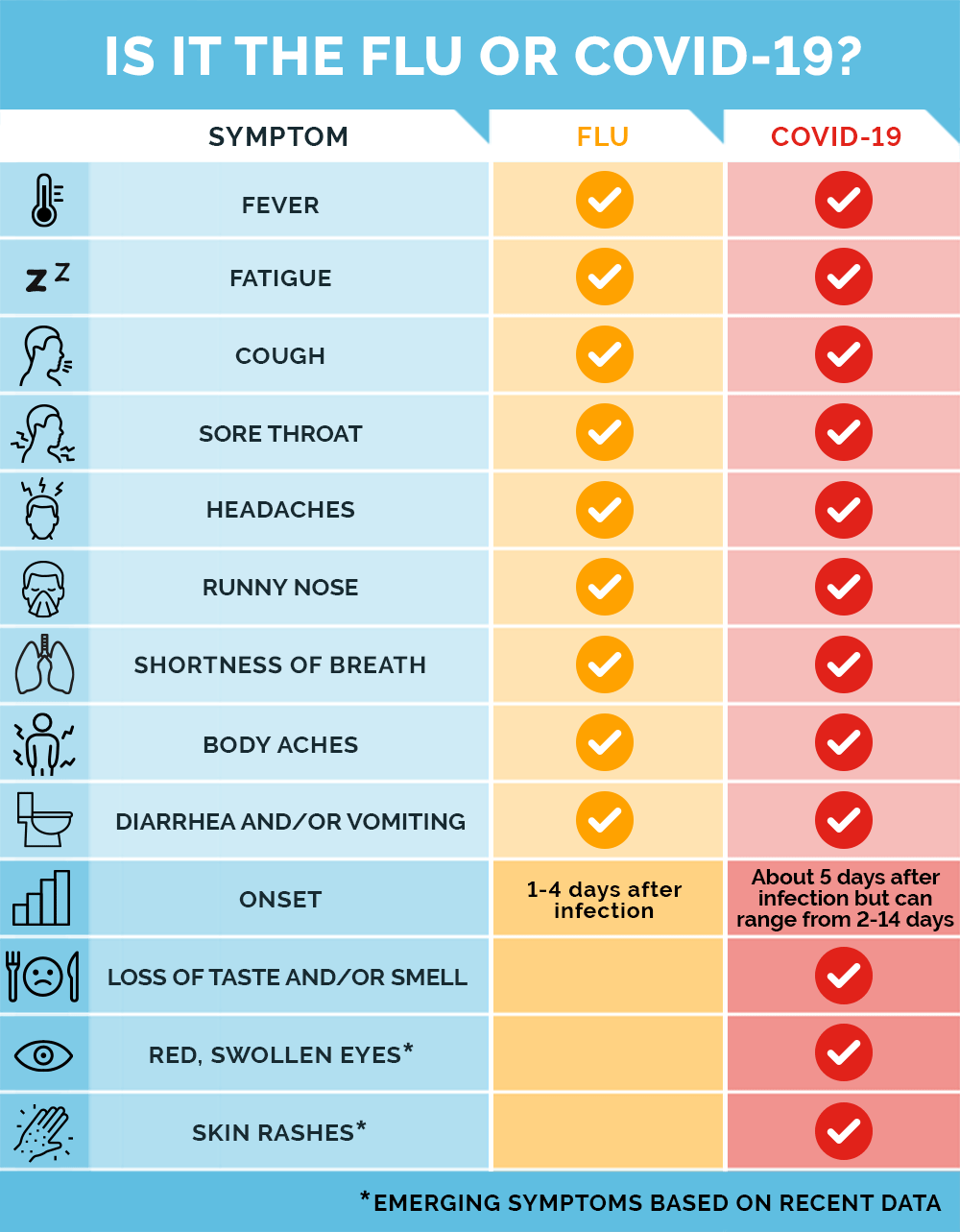How to Tell the Difference Between COVID-19 vs. Flu
An infectious disease specialist explains how the symptoms differ.

Flu season is here. Paired with the ongoing battle with COVID-19, experts have been warning that we could have a “twindemic” on our hands this year — an influenza epidemic unfolding in the middle of a relentless COVID-19 pandemic.
“The medical community is concerned that if we have an increased number of influenza cases, it will strain the hospital system on top of what’s already going on with the COVID-19 pandemic,” says Dr. Ting Ting Wong, an attending physician and infectious disease specialist at NewYork-Presbyterian Brooklyn Methodist Hospital.
Last year, the influenza virus caused an estimated 35 million illnesses in the U.S. The severity of this year’s flu season is unpredictable, but with the arrival of winter “a lot of people may be coughing and sneezing, so the likelihood of transmission is much higher when you’re having active symptoms,” adds Dr. Wong.
But what exactly are those symptoms? Just as in the spring when differentiating between seasonal allergies and COVID-19 was tricky, the challenge now will be identifying what could be signs of COVID-19 vs. flu.
Health Matters spoke with Dr. Wong to learn the similarities and differences of the coronavirus vs. flu — and how to protect yourself against both.
COVID-19 vs. Flu: What’s the Difference?
Unfortunately, “in the beginning, it may be very hard to tell the difference between influenza and COVID,” says Dr. Wong.
Even though the flu and COVID-19 are caused by totally different viruses, they share a number of symptoms: fever, fatigue, cough, sore throat, runny nose, shortness of breath, body aches, headaches, vomiting, and diarrhea.
There are, however, two distinct differences between the flu and the coronavirus that causes COVID-19.

First, the loss of taste and smell is specific to COVID-19 and is not seen in people who have the flu. “This is a very important difference to distinguish between the flu and COVID-19,” says Dr. Wong. While it may not manifest in all patients (about 38% to 55% of patients have reported loss of taste and around 40% have reported loss of smell), this specific symptom might come on anywhere from two days after contracting the virus up to 14 days after symptom onset.
Second, the way in which symptoms present themselves in patients is very different. Both the flu and COVID-19 cause a cough and shortness of breath, but overall, COVID-19 symptoms tend to last longer than the flu. “They can last for multiple weeks, if not months,” says Dr. Wong. Shortness of breath can also come later with COVID-19 and becomes more severe and long-lasting than the flu.
There are also some new and ongoing reports of symptoms associated with COVID-19 that people should be on the lookout for:
Red, swollen eyes. There have been occasional reports of red, swollen, and itchy eyes in some COVID-19 patients, which can look like conjunctivitis (or pink eye). “This is a symptom that can come on with other strains of coronavirus, so while not a distinguishing factor for COVID-19 specifically, it’s something to be watchful for,” says Dr. Wong.
Skin rashes. Viruses are often associated with rashes, so it’s not unusual for you or your child to develop one. “This was reported mostly in younger people, and we’re still gathering data on the different skin conditions that coincide with COVID-19, which have ranged from little red bumps and hives to chilblains — now temporarily called ‘COVID toes’ — which are painful, red-purple, or itchy bumps on the toes,” explains Dr. Wong.
If you or your child has any new skin condition or rash, call your doctor just to be safe. Since it can be hard for a clinician to distinguish whether a skin rash is from a COVID-19 infection or, say, hand, foot, and mouth disease (a viral infection that manifests as painful mouth sores and blisters on the palms of the hands and soles of the feet), your doctor will likely want to test you or your child for COVID-19.
How to Tell the Difference Between COVID-19 vs. Flu in Children
Reports have shown that COVID-19 is less severe in children than it is in adults. It’s also rare, making up about 1% to 2% of COVID-19 cases worldwide. That being said, multisystem inflammatory syndrome in children (MIS-C), while rare, is a condition associated with COVID-19 and can occur in children ranging from toddlers to teens.
Fever, vomiting, lethargy, and abdominal pain are symptoms to be on the lookout for. If your child is experiencing common flu symptoms coupled with any of the above symptoms, contact their pediatrician.
If there was ever a year when you were going to get a flu shot, this is the year.
Dr. Ting Ting Wong
What to Do if You Think You Have the Flu, COVID-19 — or Both
Yes, it’s possible to test positive for the flu and COVID-19 at the same time; however, according to Dr. Wong, “the chance of a coinfection is very, very low.” If you find yourself experiencing any of the symptoms discussed in this article, here’s a game plan for how to quickly determine a diagnosis.
- Talk to a doctor. If you’re coming down with a telltale sign of COVID-19 or the flu, it’s important to seek medical care, urges Dr. Wong. “Let’s say you’re coming down with a headache, fever, body aches, and fatigue. I would put on a mask, isolate yourself from your family, and talk with your doctor about your symptoms.”
- Get tested. “It’s important to be tested as quickly as possible for COVID and influenza,” says Dr. Wong. Here’s some good news: The nose swab can be used to test for both COVID-19 and the flu. Schedule an appointment with your doctor or local health clinic, or visit an urgent care where tests should be available.
- Start treatment. After a diagnosis, you can move forward with the appropriate treatment. For the flu, the gold standard is an antiviral drug that your doctor might prescribe and helps to lessen the severity of symptoms and shorten duration of the illness. For milder cases of COVID-19, most people can recover at home by monitoring their symptoms, resting, and drinking fluids.
If you are having trouble breathing, persistent pain, chest pressure, new confusion, an inability to wake or stay awake, or bluish lips or face, seek emergency medical care immediately.
How to Protect Yourself Against the Flu and COVID-19
To avoid a potential “twindemic” this year, Dr. Wong cautions, “we should be taking every precaution to prevent having a bad flu season.”
- Get a flu shot. The COVID-19 vaccine may still be rolling out, but the flu vaccine is widely available. “If there was ever a year when you were going to get a flu shot, this is the year,” says Dr. Wong. “It’s the best way to protect yourself, and it’s better to be safe than sorry.” The flu shot is now available in most pharmacies and health clinics.
- Practice safety precautions. Fortunately, the preventive measures for COVID-19 also apply for the flu: avoiding large crowds and gatherings, wearing a mask, social distancing, frequent handwashing, and staying at home when you feel sick. “These are all preventions for COVID as well as influenza transmission,” says Dr. Wong.
- Take care of your immune system. Caring for your immune system is very important to fight off infections, especially viruses. “Everyone should stay as healthy as possible. Eating a healthy, balanced diet, exercising regularly, and getting enough sleep will help boost your immune system.”
Ting Ting Wong, M.D., is an attending physician and an infectious disease specialist at NewYork-Presbyterian Brooklyn Methodist Hospital.
